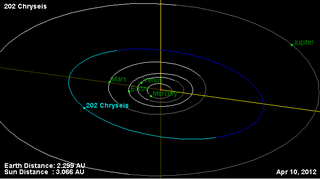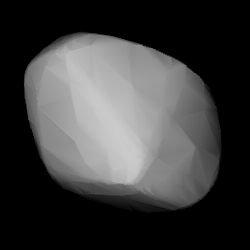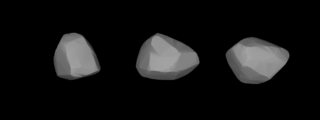Related Research Articles

Una is a fairly large and dark, primitive Main belt asteroid that was discovered by German-American astronomer C. H. F. Peters on February 20, 1876, in Clinton, New York. It is named after a character in Edmund Spenser's epic poem The Faerie Queene (1590).

168 Sibylla is a large main-belt asteroid, discovered by Canadian-American astronomer J. C. Watson on September 28, 1876. It was most likely named for the Sibyls, referring to the Ancient Greek female oracles. Based upon its spectrum this object is classified as a C-type asteroid, which indicates it is very dark and composed of primitive carbonaceous materials. 168 Sibylla is a Cybele asteroid, orbiting beyond most of the main-belt asteroids.

Arete is an asteroid in the asteroid belt. It has a very bright surface, even so when compared to other rocky S-type asteroid.

Chryseïs is a large, lightly coloured Main belt asteroid that is probably composed of silicate rocks. It was discovered by C. H. F. Peters on September 11, 1879, in Clinton, New York, and was named after the mythical Trojan woman Chryseis.

Weringia is a typical main-belt asteroid. It was discovered by Johann Palisa on 19 July 1882, and was named after Währing, part of Vienna, the city where the asteroid was discovered. Photometric observations during 2008 showed a rotation period of 11.1496 ± 0.0009 hours and a brightness variation of 0.20 ± 0.02 in magnitude.

Prymno is a somewhat large Main belt asteroid. It is classified as a B-type asteroid and probably has a primitive composition not unlike common C-type carbonaceous asteroids.

Atropos is a typical Main belt asteroid that was discovered by Austrian astronomer Johann Palisa on 8 March 1888 in Vienna.

Bavaria is a carbonaceous background asteroid from the intermediate asteroid belt, approximately 54 kilometers. It was discovered by Johann Palisa on 16 November 1890 in Vienna.

Campania is a large main belt asteroid that was discovered by French astronomer Auguste Charlois on 20 September 1893 in Nice.

380 Fiducia is a dark and large asteroid, approximately 68 kilometers in diameter, located in the central region of the asteroid belt. It was discovered by French astronomer Auguste Charlois at the Nice Observatory on 8 January 1894. The carbonaceous C-type asteroid has a rotation period of 13.7 hours. It was named "Fiducia", the Latin word for confidence.

Patricia is a large Main belt asteroid.

Senta is a minor planet orbiting the Sun that was discovered by German astronomer Max Wolf on 16 November 1904, from Heidelberg.
Bilkis is a minor planet, specifically an asteroid orbiting in the asteroid belt. It was discovered by German astronomer August Kopff in 1906 February and was given the Koran name for the Queen of Sheba. Photometric observations at the Palmer Divide Observatory in Colorado Springs, Colorado in 2006–7 were used to build a light curve for this object. The asteroid displayed a rotation period of 8.5742 ± 0.0005 hours and a brightness variation of 0.40 ± 0.02 in magnitude.
633 Zelima is a minor planet orbiting the Sun in the asteroid belt with a magnitude of 10.7. The name may have been inspired by the asteroid's provisional designation 1907 ZM.
774 Armor is a minor planet orbiting in the main belt. It was discovered on December 13, 1913, in Paris by French astronomer Charles le Morvan and was named after the Celtic region of Armorica. The asteroid is orbiting at a distance of 3.05 AU with a period of 5.32 yr and an eccentricity of 0.169. The orbital plane is inclined by an angle of 5.56° to the plane of the ecliptic.
823 Sisigambis is an asteroid belonging to the Flora family in the Main Belt. Its diameter is about 17 km and it has an albedo of 0.179. Its rotation period is unknown but appears to be greater than at least 12 hours. The asteroid is named after Sisygambis, the mother of Darius III of Persia.
901 Brunsia is an S-type asteroid belonging to the Flora family in the Main Belt. Its rotation period is 3.136 hours.
999 Zachia is a main-belt asteroid that was discovered by German astronomer Karl W. Reinmuth in 1923 and named after Hungarian astronomer Franz Xaver von Zach.
51823 Rickhusband, provisional designation 2001 OY28, is a dark Lixiaohua asteroid from the outer regions of the asteroid belt, approximately 9 kilometers in diameter.
(457175) 2008 GO98, provisional designation 2008 GO98 with cometary number 362P, is a Jupiter family comet in a quasi-Hilda orbit within the outermost regions of the asteroid belt. It was discovered on 8 April 2008, by astronomers of the Spacewatch program at Kitt Peak National Observatory near Tucson, Arizona, in the United States. This presumably carbonaceous body has a diameter of approximately 15 kilometers (9 miles) and rotation period of 10.7 hours.
References
- 1 2 Yeomans, Donald K., "937 Bethgea", JPL Small-Body Database Browser, NASA Jet Propulsion Laboratory , retrieved 2 May 2016.
- 1 2 di Martino, M.; et al. (February 1994), "Lightcurves and rotational periods of nine main belt asteroids", Icarus, vol. 107, no. 2, pp. 269–275, Bibcode:1994Icar..107..269D, doi:10.1006/icar.1994.1022.
- ↑ "Asteroid Lightcurve Parameters". Archived from the original on 14 June 2006. Retrieved 3 November 2008.